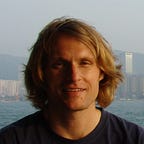TMA! Norman Foster: London’s Design Boss [SE:E7]
Video posted on July 31, 2015 (7–31–2015) on YouTube.
To judge his work in the United States, Norman Foster would not rise in the viewer’s experience to the high expectations deservedly set for this truly global architect. The Hearst Building of NYC is one of the most recently published Foster projects on this side of the Atlantic. In my opinion, it is not worth a visit.
Even if his work is lackluster in the US, Foster has admitted he was heavily influenced by an important American design theorist, Buckminster Fuller. Having worked with Bucky for the bulk of the 1970’s, Foster’s practice morphed into Bucky’s mantra, what I like to call virtue through technology, the inspiring and often untrue guiding principle of nearly every Popular Science reader, coder and geeked-out engineer of the Western World. This is what contrasts Foster from other Bucky followers, in that the 1999 Pritzker Prize Winner from the UK has found virtue in his highly technology-expressive structures. By embedding a near-absurd substrate of innovation in the mechanical systems, structure, and envelope design, even a trained admirer like myself may see he’s lost the forest for the trees. Of course, an example of this high-tech, virtuous approach is the Swiss Re project in London, located at 30 Saint Mary Axe. In fact, if you want to see Foster’s best current work, a trip to London is an easy way to see Too Much Foster! in less than a day’s time of walking, as for now his work still dominates many of the most iconic portions of this city’s viewshed.
Unfortunately, in order to see inside the Swiss Re, you’ll need a formal invitation. Or, simply watch Woody Allen’s 2005 Match Point, a film that shows the building working from the inside. Perhaps security is important for the tenants due to the fact the former building, the Baltic Exchange, was bombed by the IRA in April of 1992. Although Europeans generally describe the building as a cucumber, or “Gherkin”, others dignify the structure as an anchored rocket, ready for blast-off. No matter any fault of its shape or heritage, the building is the best of Foster’s in expressing the inspiration planted by Bucky, yet reserves the real estate for his true muse, the unabashed capitalist.
In reviewing those of Foster’s projects meant for full public enjoyment, the structures themselves feel well intentioned but are wrought with an air of needy approval. For evidence, first visit Berlin’s Reichstag, completed in 1999 with it glass dome, then the Great Court at the British Museum, completed in 2000. Each give the public access to his high-tech aesthetic, begging for recognition in contrast to that which is an outside backdrop. In these projects, you are well aware of the glass pane as an object of separation, a thing that is seen in its place of translucent existence.
Less needy, yet still trademarked with Foster’s tech virtue are the Millennium Bridge completed in 2000 and the Mayor of London’s City Hall of 2002. Both projects elevate the user and their enjoyment of the City above the design ego or his client. As history has taught us, London is a city of commerce and financial dominance; an “official” architectural aesthetic for the city without the air of wealth and exclusion would be unfit. And as London’s now official design boss, this strange both-and public-exclusivity temper defines the Canary Wharf Underground Station, a place built on a promise of tax freedom and the private annexation of public territory. Distasteful to many, this entire development epitomizes the perfect world for Foster’s work.
Or does it?
There is still Hong Kong. A commercial colony now the territory of a hungry communist nation. On my last short trip to this city of extremes, I enjoyed my flight into and out of the Hong Kong airport, a beautiful project by Foster’s firm. While there, I had to visit Foster’s real start on the path to high-tech virtue, a journey that began after Bucky.
It truly began with the audacious and daring headquarters for the Hong Kong and Shanghai Bank, completed well before its time in 1986. With a large public interior impressed with a muscular private tower, perhaps Foster peaked at the start of his course with HKSB. Strange, new and obsessive with each year it exists, this place is both the progeny of Bucky’s inspiring concept for a better populist world, yet stubbornly symbolic of the economic imperialism that was inevitable for the future Lord Foster of Thames Bank.
